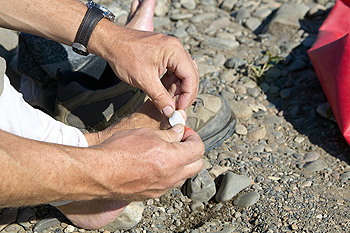
Foot blisters while hiking are caused by friction, heat, and moisture building up between the skin and footwear. Common symptoms include redness, tenderness, and fluid-filled pockets. Risk factors include wearing ill-fitting shoes, sweaty feet, and long treks without breaks. Prevention involves wearing moisture-wicking socks, properly fitted hiking boots, and using blister pads or foot powders. Keeping feet dry and taking regular rest breaks can also reduce risk. If a blister becomes painful or shows signs of infection such as redness, swelling, or pus, it is important to seek medical attention. A podiatrist can clean and treat the area, prevent complications, and offer guidance for future hikes. If you have developed a foot blister that shows signs of infection, it is suggested that you consult this type of doctor who can safely treat foot blisters, and offer prevention tips.
Blisters are prone to making everyday activities extremely uncomfortable. If your feet are hurting, contact Stephanie Tine, DPM of Flamingo Foot and Ankle. Our doctor can provide the care you need to keep you pain-free and on your feet.
Foot Blisters
Foot blisters develop as a result of constantly wearing tight or ill-fitting footwear. This happens due to the constant rubbing from the shoe, which can often lead to pain.
What Are Foot Blisters?
A foot blister is a small fluid-filled pocket that forms on the upper-most layer of the skin. Blisters are filled with clear fluid and can lead to blood drainage or pus if the area becomes infected.
How Do Blisters Form?
Blisters on the feet are often the result of constant friction of skin and material, usually by shoe rubbing. Walking in sandals, boots, or shoes that don’t fit properly for long periods of time can result in a blister. Having consistent foot moisture and humidity can easily lead to blister formation.
Prevention & Treatment
It is important to properly care for the affected area in order to prevent infection and ease the pain. Do not lance the blister and use a Band-Aid to provide pain relief. Also, be sure to keep your feet dry and wear proper fitting shoes. If you see blood or pus in a blister, seek assistance from a podiatrist.
If you have any questions, please feel free to contact our office located in Fort Lauderdale, FL . We offer the newest diagnostic and treatment technologies for all your foot care needs.